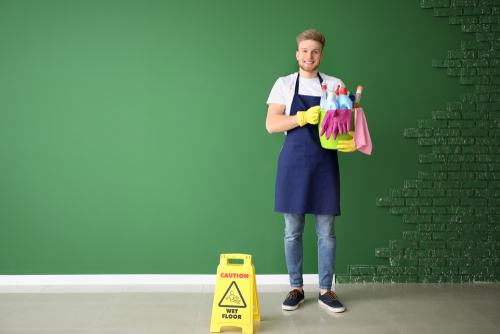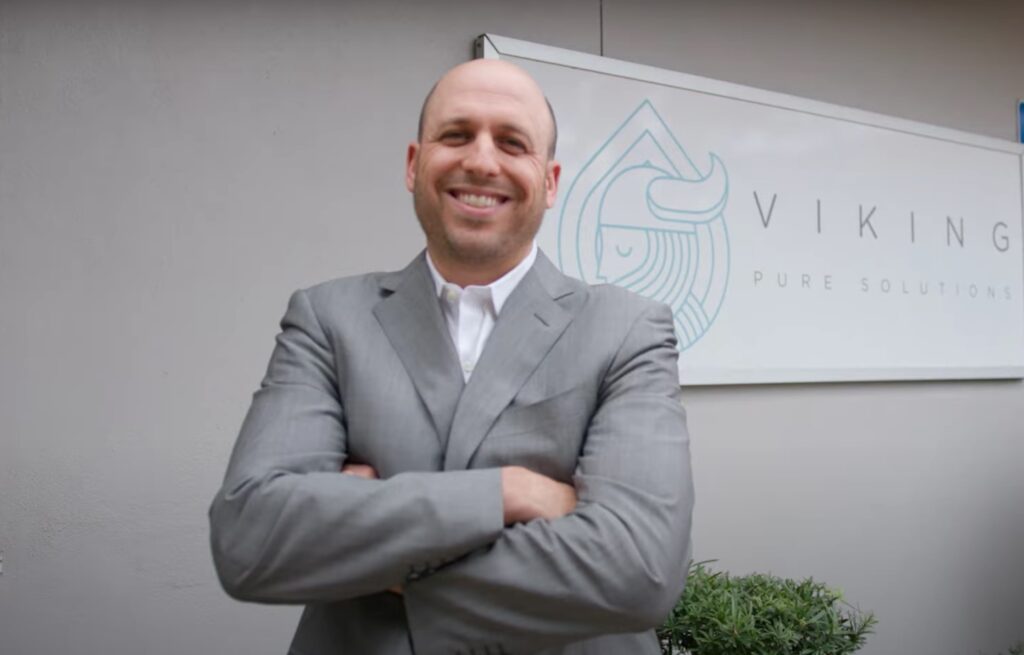In commercial facilities, green management practices play a crucial role in protecting the environment, enhancing human health, achieving economic savings, fulfilling social responsibilities, and ensuring long-term competitiveness and compliance.

By embracing sustainable practices, these buildings not only contribute to a healthier planet but also create a safer, more efficient, and more appealing environment for all stakeholders involved.
As the global focus on sustainability intensifies, the push for greener cleaning practices in facilities has become more prominent. However, transitioning to eco-friendly cleaning methods can have its challenges. Let’s look at some of the primary obstacles and examine solutions to overcome them.
Replacing Toxic and Unsustainable Commercial Cleaning Products with Green Alternatives
Many commercial cleaning products contain harmful chemicals that can adversely affect both human health and the environment. These products often include volatile organic compounds (VOCs), per- and polyfluoroalkyl substances (PFAS), and other hazardous substances.
PFAS and VOCs are associated with a range of health issues. PFAS, often referred to as “forever chemicals” due to their persistence in the environment and human body, have been linked to cancer, liver damage, immune system effects, and developmental issues in children. VOCs can cause respiratory problems, headaches, and eye, nose, and throat irritation.
VOCs also contribute to poor indoor air quality by releasing harmful gases into the air. This can lead to short and long-term health problems for building occupants. Green alternatives typically have low or no VOC content, promoting a healthier indoor environment.
PFAS, in turn, are highly persistent in the environment and can accumulate in soil and water, causing long-term ecological damage. VOCs contribute to air pollution and can form ground-level ozone, a component of smog. Green cleaning products are designed to be biodegradable and less harmful to ecosystems.
Cleaning staff who handle these toxic chemicals are at higher risk of exposure-related health issues. Green cleaning products are generally safer to handle, reducing the risk of chemical burns, respiratory issues, and other health hazards.
Green cleaning products clearly provide a safer alternative to traditional cleaners with toxic ingredients. So, why isn’t everyone doing this, everywhere?
Switching from traditional cleaners with toxic ingredients to green alternatives can be challenging for several reasons. These challenges span across financial, practical, and perceptual barriers.
The Knowledge Gap
One of the primary challenges is a lack of knowledge. Facilities managers and cleaning staff may not be fully aware of the harmful effects of traditional cleaners or the benefits of green alternatives. This lack of knowledge can result in resistance to change.
Misunderstanding efficacy is another challenge—there is a common misconception that green products do not exist that are as effective as traditional cleaners. This belief can stem from a lack of education on available green products or from negative experiences with inferior green products.
Simple resistance to change is a third challenge; staff may be accustomed to using traditional cleaners and may resist changing their routine. There is also a commonly held belief that cleaners with strong scents are more effective—in reality, these fragrances are typically just an added component to these cleaning solutions and often are harmful ingredients.
Staff may be accustomed to using traditional cleaners and may resist changing their routine. Training and adapting to new products and practices can be seen as an inconvenience.
Switching to new products sometimes involves a learning curve. Cleaning staff might be hesitant to adopt new methods and products due to fear of reduced performance or potential complaints from building occupants.
Greenwashing: Wading Through the Marketing Myths
Forward-thinking facilities managers who do recognize the importance of sustainability also face another challenge—parsing through the wide variety of products and services available and making sure that they’ve selected the right one.
Many products are marketed as “green” or “eco-friendly” without any substance or evidence that backs these claims. This phenomenon, known as “greenwashing,” can mislead facilities managers into choosing products that are not genuinely sustainable.
Facilities managers should educate themselves on common greenwashing tactics and verify product claims by checking for third-party certifications and scientific evidence supporting the product’s environmental benefits.
Demanding transparency is important as well. It’s important to engage with manufacturers to provide full ingredient lists and proof of sustainability claims. Look for certifications like Green Seal, EcoLogo, or the EPA’s Safer Choice, which ensure the product meets rigorous environmental standards.
Education, it turns out, is one of the most important resources in developing a sound strategy towards sustainability.
Conducting an Audit—Knowing Where You Stand
Identifying the most effective, efficient, and eco-friendly cleaning practices requires a comprehensive review of current procedures—you need to look at all cleaning products currently in use and their chemical compositions.
It’s also important to assess current cleaning practices to identify areas where improvements can be made.
Define the goals of the audit. Are you looking to reduce harmful chemical use, improve efficiency, or enhance sustainability?
Gather a team that includes facilities managers, cleaning staff, and sustainability experts. Their diverse perspectives will provide comprehensive insights. Familiarize yourself with existing cleaning policies, procedures, and any regulatory requirements or green cleaning standards your facility aims to meet. Speak with cleaning staff to understand their experiences, challenges, and suggestions for improvement. Their firsthand insights are invaluable. If possible, measure the indoor air quality to check for the presence of harmful substances that might be emitted by cleaning products.
Compare your current practices against industry standards and best practices for green cleaning. Refer to guidelines from organizations like Green Seal, EcoLogo, or the U.S. Green Building Council (USGBC).
Highlight areas where your current practices fall short of these standards and where improvements can be made.
By following these steps, facilities can conduct thorough audits of their cleaning practices, ensuring they are effective, efficient, and environmentally friendly. This systematic approach not only enhances cleanliness and safety but also contributes to broader sustainability goals.
A New Wave of Green Technology and On-Site Generation
The push for sustainability has led to significant advancements in green cleaning technology. Traditional cleaning methods, often reliant on toxic chemicals and unsustainable practices, are being replaced by new solutions like electrolyzed water and on-site generation systems. These technologies are not only effective but also align perfectly with companies’ sustainability goals.
Electrolyzed water, commonly known as e-water, is created by passing an electrical current through a solution of water and salt. This process produces two distinct solutions: one with strong disinfectant properties (hypochlorous acid) and another with powerful cleaning and degreasing capabilities (sodium hydroxide). Both solutions are natural and highly effective in various cleaning and sanitizing applications.
E-water has multiple benefits that may make it an attractive option for facilities seeking a more sustainable footprint:
Environmental Safety: E-water is free from harmful chemicals, making it safe for the environment. Unlike conventional cleaning products that can contaminate water sources and harm wildlife, e-water breaks down into simple, harmless substances.
Health Advantages: E-water eliminates the risk of exposure to toxic chemicals for both cleaning staff and building occupants. This results in improved indoor air quality and a healthier environment.
Cost-Effectiveness: While the initial setup for e-water generation systems may be higher, the long-term savings are significant. Facilities no longer need to purchase large quantities of chemical cleaners, reducing ongoing costs.
Effectiveness: Despite being non-toxic, e-water is effective at killing pathogens, including bacteria, viruses, and fungi, and can be 80-100 times more powerful than bleach.
On-Site Generation Systems: Enhancing Sustainability
On-site generation systems allow facilities to produce cleaning and disinfecting solutions on demand. These systems use water, electricity, and sometimes salt, to create various cleaning agents through processes like electrolysis. By generating cleaning solutions on-site, companies can reduce their reliance on commercial cleaning products and improve their sustainability.
Here are some potential advantages of on-site generation:
Reduced Chemical Footprint: On-site generation drastically reduces the need for transporting and storing hazardous chemicals. This minimizes the environmental impact associated with the production, packaging, and disposal of traditional cleaning products.
Resource Efficiency: These systems promote efficient use of resources, as they only produce the amount of cleaning solution needed at any given time. This reduces waste and conserves materials.
Lower Operational Costs: By generating cleaning solutions on-site, companies can significantly cut down on purchasing and logistics costs. The consistent availability of cleaning agents also eliminates the risk of supply chain disruptions.
Enhanced Safety: On-site generation systems can produce solutions that are safe for both users and the environment. This can reduce the health risks associated with handling and exposure to conventional chemical cleaners.
The new wave of green cleaning technology, such as e-water and on-site generation systems, is revolutionizing how facilities approach cleanliness and sustainability. These technologies offer substantial environmental, health, and economic benefits, making them essential tools for companies aiming to meet their sustainability goals. By embracing these innovations, businesses can not only enhance their operational efficiency but also contribute to a healthier planet for future generations.

Joshua Schwartz is the president and co-founder of green cleaning product company Viking Pure Solutions.
